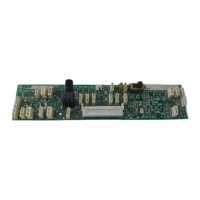10
AMPLUS™ 100 THEORY OF OPERATION
Sheet 3 of 3 (continued)
The power amplifier is equipped with a clip detector circuit, implemented with U503 [D7],
an LM311 comparator, and associated parts. The comparator watches the differential input
voltage at the power amplifier input pins and compares it to 120mV. If the power amplifier,
a feedback amplifier, is for any reason unable to deliver the output voltage requested by
the source, linear operation ceases and an error voltage develops across its input pins.
Inability to deliver the requested output voltage can occur if there is a short circuit on the
amplifier output, a DC offset from some kinds of failures, or from overdriving the amplifier.
Whatever the cause, if the input error voltage exceeds the threshold, the LM311 output
will go low, toward the -12V supply. Active (low-going) CLIP / SC signals are fed through
J7 pin 12 back to the VCA volume control IC, U204 on Sheet 1 [C2], where they turn the
gain down to eliminate the stress of the overload situation. If the power amplifier starts to
clip, the feedback signal acts as a limiter to keep the amplifier out of the distorted clipping
region.
The AmPlus 100 power supply can be configured for either 120V (60Hz) or 230V (50 or
60Hz) AC mains by the appropriate placement of jumpers J603, J605, J606. This is
shown on Sheet 3 at coordinates A6, 7, and 8. The AC mains voltage is stepped down
and rectified, creating unregulated ±40V and ±20V rail pairs for use by the power amplifier.
Regulators U600, 601 [A3] derive ±12V from the ±20V supplies for use by the op amp
circuits. The bridge rectifiers B600, and B601 are fused against overload, while the ±12V
supply is fused by 1/4 watt resistors R602, and R603. Also on Sheet 3, [B2], are Q600
and Q601, the relay drive transistors controlled by RELAY, from Sheet 2.

